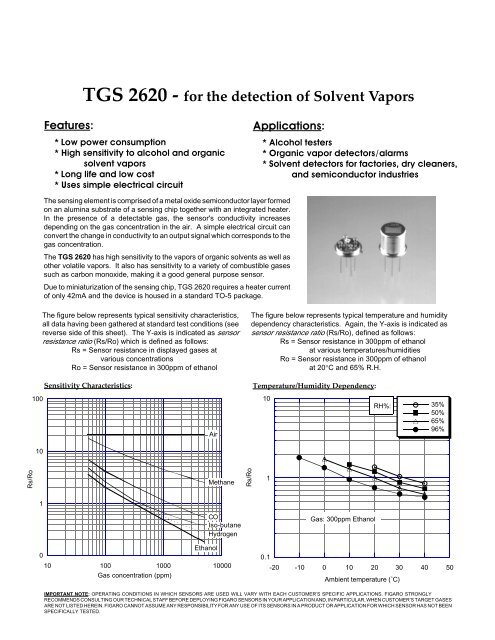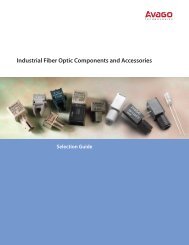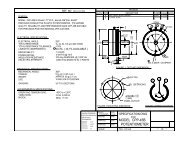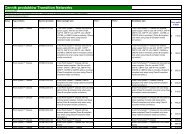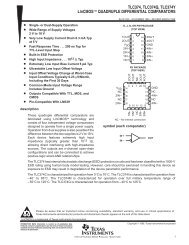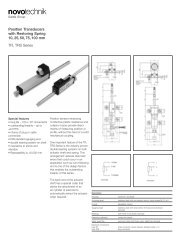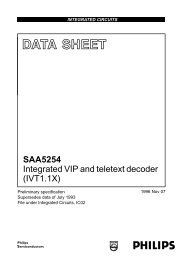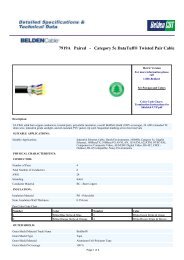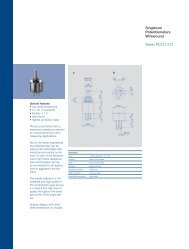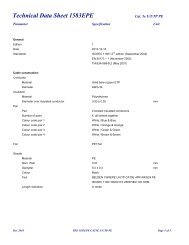TGS 2620 - for the detection of Solvent Vapors - Meditronik
TGS 2620 - for the detection of Solvent Vapors - Meditronik
TGS 2620 - for the detection of Solvent Vapors - Meditronik
- No tags were found...
Create successful ePaper yourself
Turn your PDF publications into a flip-book with our unique Google optimized e-Paper software.
PRODUCT INFORMATION<strong>TGS</strong> <strong>2620</strong> - <strong>for</strong> <strong>the</strong> <strong>detection</strong> <strong>of</strong> <strong>Solvent</strong> <strong>Vapors</strong>Features:* Low power consumption* High sensitivity to alcohol and organicsolvent vapors* Long life and low cost* Uses simple electrical circuitApplications:* Alcohol testers* Organic vapor detectors/alarms* <strong>Solvent</strong> detectors <strong>for</strong> factories, dry cleaners,and semiconductor industriesThe sensing element is comprised <strong>of</strong> a metal oxide semiconductor layer <strong>for</strong>medon an alumina substrate <strong>of</strong> a sensing chip toge<strong>the</strong>r with an integrated heater.In <strong>the</strong> presence <strong>of</strong> a detectable gas, <strong>the</strong> sensor's conductivity increasesdepending on <strong>the</strong> gas concentration in <strong>the</strong> air. A simple electrical circuit canconvert <strong>the</strong> change in conductivity to an output signal which corresponds to <strong>the</strong>gas concentration.The <strong>TGS</strong> <strong>2620</strong> has high sensitivity to <strong>the</strong> vapors <strong>of</strong> organic solvents as well aso<strong>the</strong>r volatile vapors. It also has sensitivity to a variety <strong>of</strong> combustible gasessuch as carbon monoxide, making it a good general purpose sensor.Due to miniaturization <strong>of</strong> <strong>the</strong> sensing chip, <strong>TGS</strong> <strong>2620</strong> requires a heater current<strong>of</strong> only 42mA and <strong>the</strong> device is housed in a standard TO-5 package.The figure below represents typical sensitivity characteristics,all data having been ga<strong>the</strong>red at standard test conditions (seereverse side <strong>of</strong> this sheet). The Y-axis is indicated as sensorresistance ratio (Rs/Ro) which is defined as follows:Rs = Sensor resistance in displayed gases atvarious concentrationsRo = Sensor resistance in 300ppm <strong>of</strong> ethanolSensitivity Characteristics:The figure below represents typical temperature and humiditydependency characteristics. Again, <strong>the</strong> Y-axis is indicated assensor resistance ratio (Rs/Ro), defined as follows:Rs = Sensor resistance in 300ppm <strong>of</strong> ethanolat various temperatures/humiditiesRo = Sensor resistance in 300ppm <strong>of</strong> ethanolat 20°C and 65% R.H.Temperature/Humidity Dependency:100Air10RH%:35%50%65%96%10Rs/RoMethaneRs/Ro110EthanolCOIso-butaneHydrogen10 100 1000 10000Gas concentration (ppm)Gas: 300ppm Ethanol0.1-20 -10 0 10 20 30 40 50Ambient temperature (˚C)IMPORTANT NOTE: OPERATING CONDITIONS IN WHICH SENSORS ARE USED WILL VARY WITH EACH CUSTOMER’S SPECIFIC APPLICATIONS. FIGARO STRONGLYRECOMMENDS CONSULTING OUR TECHNICAL STAFF BEFORE DEPLOYING FIGARO SENSORS IN YOUR APPLICATION AND, IN PARTICULAR, WHEN CUSTOMER’S TARGET GASESARE NOT LISTED HEREIN. FIGARO CANNOT ASSUME ANY RESPONSIBILITY FOR ANY USE OF ITS SENSORS IN A PRODUCT OR APPLICATION FOR WHICH SENSOR HAS NOT BEENSPECIFICALLY TESTED.
Basic Measuring Circuit:The sensor requires two voltage inputs:heater voltage (VH) and circuit voltage(VC). The heater voltage (VH) is appliedto <strong>the</strong> integrated heater in order tomaintain <strong>the</strong> sensing element at aspecific temperature which is optimal<strong>for</strong> sensing. Circuit voltage (VC) isapplied to allow measurement <strong>of</strong> voltage(VRL) across a load resistor (RL) whichis connected in series with <strong>the</strong> sensor.A common power supply circuit can beused <strong>for</strong> both VC and VH to fulfill <strong>the</strong>sensor's electrical requirements. Thevalue <strong>of</strong> <strong>the</strong> load resistor (RL) should bechosen to optimize <strong>the</strong> alarm thresholdvalue, keeping power consumption (PS)<strong>of</strong> <strong>the</strong> semiconductor below a limit <strong>of</strong>15mW. Power consumption (PS) willbe highest when <strong>the</strong> value <strong>of</strong> Rs isequal to RL on exposure to gas.Specifications:Modelnumber<strong>TGS</strong> <strong>2620</strong>Structure and Dimensions:Top viewSensingelement typeD1StandardTypicalTargetpackagegases<strong>detection</strong> rangeTO-5 metal canAlcohol, <strong>Solvent</strong> vapors50 ~ 5,000 ppmStandard circuitconditionsHeaterVoltage VH 5 . 0± 0.2V DC/ACCircuitvoltage VC 5 . 0± 0.2V DC/ACPs≤ 15mWLoadresistance RL Variable0.45kΩ min.Side viewHeaterresistanceRH83Ω at room temp.(typical)Electricalcharacteristicsunder standard testconditionsHeatercurrent IH 42± 4mAHeater powerconsumptionSensorresistancePHRsapprox. 210mW1 ~ 5 kΩ in 300ppm ethanolSensitivity(change ratio <strong>of</strong> Rs)0.3 ~ 0.5Rs (300ppm)Rs (50ppm)Bottom viewStandard testconditionsTest gas conditionsCircuit conditionsConditioningbe<strong>for</strong>e testperiodEthanol vapor in aira t 20± 2 ˚C, 65± 5%RHVC = 5. 0± 0.01V DCVH = 5. 0± 0.05V DC7 daysThe value <strong>of</strong> power dissipation (PS) canbe calculated by utilizing <strong>the</strong> following<strong>for</strong>mula:(VC - VRL) 2PS =RSSensor resistance (Rs) is calculated witha measured value <strong>of</strong> VRL by using <strong>the</strong>following <strong>for</strong>mula:RS =VC - VRLVRLx RLREV: 10/00


